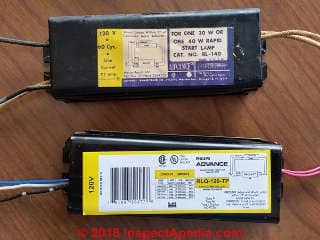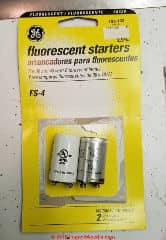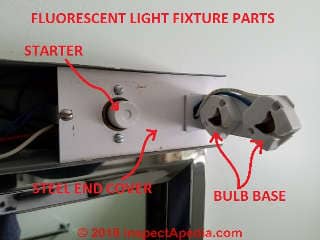 Fluorescent Light Repairs -
Fluorescent Light Repairs -
Diagnose & fix flickering, dim, humming or dead fluorescent lights
- POST a QUESTION or COMMENT about fixing flickering, dim, humming or dead fluorescent lights
Steps in diagnosing and repairing a flickering fluorescent light:
When one or more fluorescent light fixtures are humming or flickering or if the light simply won't turn on, the problem may be something as simple as a bad fluorescent bulb.
But there are other causes of flickering lights: some are also trivially easy to repair while others require more expertise and cost. Here we sort out the causes and cures for flickering fluorescent lights, and we give details for wiring connections when replacing the ballast or transformer for the fluorescent light fixture shown.
This article series explains how to diagnose and repair fluorescent lights in buildings.
Watch out: flickering or dimming lights might indicate a dangerous condition risking a building fire or an electrical shock. If the simple bulb or starter repairs we describe here don't cure the flickering, switch off the bad-acting light fixture, leave it off, and ask for help from a licensed electrician.
InspectAPedia tolerates no conflicts of interest. We have no relationship with advertisers, products, or services discussed at this website.
- Daniel Friedman, Publisher/Editor/Author - See WHO ARE WE?
Fix Flickering, Buzzing, Humming or "Dead" Fluorescent Lights
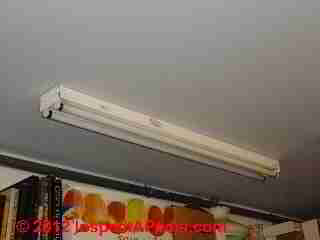 Here we discuss the diagnosis and repair of flickering or humming fluorescent light fixtures. The diagnosis and wiring diagrams shown here are for a 30-W T8-type two-bulb light fixture.
Here we discuss the diagnosis and repair of flickering or humming fluorescent light fixtures. The diagnosis and wiring diagrams shown here are for a 30-W T8-type two-bulb light fixture.
The diagnostic procedures for other fluorescent light fixtures will be the same, though the final wiring details will differ for other models of ballast or transformer.
[Click to enlarge any image]
Separately at ELECTRIC POWER LOSS / FLICKERING LIGHTS- home - we give the causes (and cures) of all types of flickering lights.
Watch out: flickering or dimming lights at a building may be more than an inconvenience. While some causes of flickering lights may be normal and harmless, such as flickering in certain types of light bulbs, many others indicate a dangerous condition, risking fire, shock, injury or worse.
The safest approach is to turn off electrical circuits or components that are causing flickering or dimming or acting strangely in any way.
If you cannot safely access your electrical panel to turn off dangerous circuits or components, leave the building and call your local emergency services.
At FLOOD & DISASTER BUILDING DAMAGE REPAIR PROCEDURES we list emergency numbers for various countries from Australia (000) to the U.K. (112). In Canada or the U.S. call 911. In Mexico call 066.
[Click to enlarge any image]
A fluorescent light fixture may be the only electrical device that is flickering, for any of several reasons we will explain below. Other causes of flickering lights are very dangerous.
Below: our photo shows arc flash burning found inside of a fluorescent light fixture that was dis-assembled for inspection and repair.
After changing to a known-good bulb and trying a new starter I figured that the ballast was probably bad. On opening the fixture for further inspection I found signs of overheating at wiring to the ballast, suggesting that replacing the ballast made sense.
A challenge can be to select the proper replacement ballast or transformer and to make sure that it can support the bulbs that will be used in the fixture.
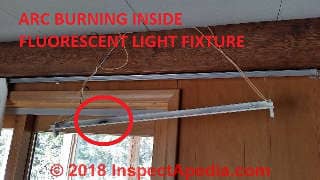
Article Series Contents
- FLUORESCENT LIGHT REPAIRS - you are on this page - continue below
- HOW FLUORESCENT LIGHTS WORK
- ELECTRIC POWER LOSS / FLICKERING LIGHTS
- DIAGNOSE a BAD FLUORESCENT LAMP / BULB
- LED BULB REPLACES FLUORESCENT
- REPLACE a FLUORESCENT LAMP / BULB
- FLUORESCENT LIGHT BALLAST TYPES
- FLUORESCENT LIGHT BULB CODES & TYPES
- FLUORESCENT LIGHT BULB PHOTOS
- FLUORESCENT LIGHT BULB COLOR TEMPERATURE
- FLUORESCENT LIGHT FLICKERING CAUSES
- FLUORESCENT LIGHT STARTER REPLACEMENT
- FLUORESCENT LIGHT TRANSFORMER / BALLAST REPLACEMENT
- FLUORESCENT LIGHT TRANSFORMER / BALLAST TYPES
- FLUORESENT BULB SOCKET TYPES
- FLUORESCENT LAMP CONNECTOR / SOCKET REPLACEMENT
- FLUORESCENT LIGHT FIXTURE BULB / BALLAST DISPOSAL
- FLUORESCENT LAMP INSTRUCTIONS, PARTS, REPLACEMENTS
Watch out: Changing a fluorescent lamp or bulb and changing the fluorescent lamp starter (if your lamp uses a starter) are easy tasks within the ability of most homeowners or occupants.
Electrical wiring is a different story: if you are not trained and comfortable with proper electrical wiring and repair work, hire someone who is qualified.
Making a mistake can cause a building fire, shock, injury, or death.
How do Fluorescent Light Fixtures Work to Produce Light?
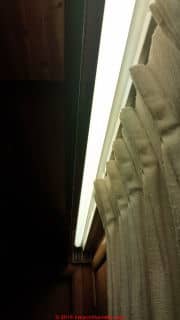 A fluorescent lamp is a “gaseous discharge” light source.
A fluorescent lamp is a “gaseous discharge” light source.
Fluorescent light is produced by passing an electric arc between tungsten cathodes in a neon tube filled with a very low pressure mercury vapor (about 0.3 atm) and an inert gas such as argon, neon, or krypton.
The electric current or arc excites the low-pressure mercury vapor which generates radiant energy, primarily in the ultraviolet or UV range.
The inert gases (instead of air that contains oxygen) help prevent oxidation or combustion of the mercury inside the tube.
[Click to enlarge any image]
This radiant energy causes the phosphor coating on the inside of the tube to “fluoresce,” converting the ultraviolet light (invisible to the human eye) into visible light.
By changing the composition of the phosphor coating the manufacturer can change the color temperature of the light emitted by the tube.
Start-up Voltage vs. Operating Voltage
Let's look at just how a fluorescent lamp works in more detail.
Fluorescent lamps have two electrical requirements. Start-up voltage and operating voltage.
To start the lamp, a high voltage surge is needed to establish an arc in the mercury vapor between the lamp filaments at each end of the lamp tube.
Those filaments remain hot as long as the tube is lit or "on". The flow of electrons between the lamp filaments excites the electrons in atoms of mercury inside the tube, causing them to emit radiant energy in the form of UV (ultraviolet) light.
The high start-up voltage, at 400-600 V, is supplied by an electrical transformer or ballast in the light fixture.
Once the lamp is started, the gas offers a decreasing amount of resistance, which means that current must be regulated to match this drop. Once the lamp is operating, voltage drops to a much lower level, usually around 93V for tubes under 30 Watts, or from 100-175 V for tubes at 30 Watts or more.
How the Starter Fires Up the Fluorescent Lamp
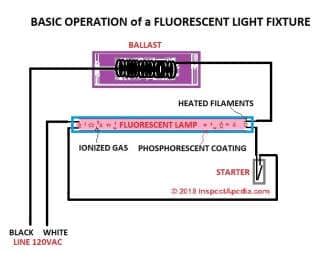
Our sketch above illustrates the basics of how a fluorescent lamp works. [Click to enlarge any image]
Line voltage enters the ballast / transformer where it is converted to high voltage to operate the lamp
When the circuit supplying the lamp is switched ON, current passes first through the ballast, then across the filaments at one end of the lamp, following the path of least resistance through the starter switch and on through the filaments at the other end of the lamp.
Current flowing through the starter, itself filled with neon or a similar gas, causes an arc between the two contacts in the starter, essentially closing the circuit across the starter switch to permit a high initial voltage to flow to the lamp filaments causing them to heat up, boiling electrons off of the filament surface, ionizing the gas inside the tube or lamp and causing it to light.
As current continues to flow through the starter, a bimetallic strip in the starter heats, curves to close a metal-to-metal contact, stopping the arc inside the starter (as current now flows through the metal contacts). Stopping the arc inside the starter allows its bimetallic strip to cool, opening the starter circuit.
Because current is now flowing through the ionized gas inside the fluorescent lamp the starter is no longer needed.
Once successfully lit, the fluorescent lamp remains on, operating at a lower voltage, giving off light as the ionized gas excites the phosphorescent coating on the inside of the lamp tube.
When the circuit supplying power to the lamp is switched OFF, current ceases to flow through the fluorescent lamp - it is turned off.
- adapted from FLUORESCENT LIGHT STARTER REPLACEMENT and from Sylvania and other sources cited in detail
at FLUORESCENT LAMP INSTRUCTIONS, PARTS, REPLACEMENTS
Fluorescent lamps operate at a very low gas pressure.
Changing the composition of the phosphor powder inside fluorescent tubes changes the spectrum of light produced.
Mercury is present in the lamp in both the phosphor powder and in the vapor.
Fluorescent lamps are more energy efficient than incandescent light bulbs of an equivalent brightness because more of the energy input is converted to usable light and less is converted to heat.
They also have a longer lamp life since there is no filament to burn out. - sources: adapted from IMERC & Sylvania cited in detail
at FLUORESCENT LIGHT FIXTURE BULB / BALLAST DISPOSAL and
at FLUORESCENT LAMP INSTRUCTIONS, PARTS, REPLACEMENTS respectively.
Recommended spot to keep reading: ELECTRIC POWER LOSS / FLICKERING LIGHTS
Fluorescent Lamp, Bulb, Socket, Starter & Ballast / Transformer Sources, Instructions
- General Electric, LED T8 UNIVERSAL TUBES INSTALLATION INSTRUCTIONS [PDF] for LEDs used to replace traditional T8 Fluorescent lamps in luminaries.
- Maine DEP, WHAT IF I ACCIDENTALLY BREAK A CFL, FLUORESCENT BULB ... IN MY HOME [PDF] Main Department of Environmental Protection, retrieved 2018/09/17, original source: https://www.maine.gov/dep/homeowner/cflbreakcleanup.html
[Click to enlarge any image]
- NLPIP, "What is the Light Output of T8 Fluorescent Lamps" (2006), [web article], National Lighting Product Information Program (NLPIP), Lighting Research Center, Rensselaer Polytechnic Institute, Troy, NY 12180 USA Vol. 9 No. 1, June 2006, retrieved 2018/09/17, original source: https://www.lrc.rpi.edu/programs/NLPIP/lightingAnswers/t8/02-t8-light-output.asp
- NLPIP, T8 FLUORESCENT LAMPS [PDF] (1993), National Lighting Product Information Program (NLPIP), Lighting Research Center, Rensselaer Polytechnic Institute, Troy, NY 12180 USA Vol. 1 No. 1, June 2006, retrieved 2018/09/17, original source: https://www.lrc.rpi.edu/programs/NLPIP/lightinganswers/pdf/view/LAT8.pdf
Excerpt:
In 1981, the 32-watt T8 lamp was introduced in the United States, providing further improvements in the efficacy of 4-foot fluorescent lamps. - Osram Sylvania, FLUORESCENT LIGHT BALLAST TECHNOLOGY [PDF], retrieved 2018/09/17, original source: https://www.sylvania.com/en-us/innovation/education/light-and-color/Pages/ballasts-technology.aspx
- Osram Sylvania, FLUORESCENT TECHNOLOGY, www.sylvania.com/LearnLighting/LightAndColor/FluorescentTechnology [obsolete link]
- Osram Sylvania Lighting, Website: http://www.sylvania.com, LEDVANCE North American Headquarters
200 Ballardvale Street, Wilmington, MA 01887 USA,
Help for U.S. Consumers: Tel: 800-lightbulb (544-4828) Email: lightbulb@ledvance.com
LEDVANCE Canadian Lighting Headquarters, 5450 Explorer Drive, Suite 100 Mississuaga, Ontario L4W 5N1 Canada Phone: 905-361-9333
Help for Canadian Consumers: Tel: 800-720-2852 Email: lightbulb@ledvance.com - Phillips, 10275 W. Higgins Rd., Rosemont IL 60018 USA, Customer Support Tel: 800-372-3331 Website: www.phillips.com/Advance
Phillips website also offers transformer cross-reference tables to help find the proper replacement unit for your fluorescent light fixture. - Universal Lighting Technologies, BALLAST NAVIGATOR CATALOG [PDF] provides a guide to selecting ballasts for all types of fluorescent light fixtures, Universal Lighting Technologies, TEl: 1-800-BALLAST, Website: https://unvlt.com/literature/ballast-navigator/ produces electronic ballasts for fluorescent light fixtures. Universal produces the Triad® brand of lamp ballasts.
- U.S. DOE, LED REPLACEMENTS for FOUR-FOOT LINEAR FLUORESCENT LAMPS [PDF], (2011) U.S. Department of Energy, EERE Information Center, website: www.eere.energy.gov, retrieved 2018/09/17. original source http://cool.conservation-us.org/byorg/us-doe/led-t8-fluorescent-replacement.pdf
Excerpt:
Summary: LED replacement products have improved in light output and efficacy but do not appear to provide equivalent light output, color quality, distribution, or cost-effectiveness, compared to four-foot linear fluorescent lamps. DOE will continue to monitor and report on developments in this product category. - U.S. DOE, Performance of T12 and T8
Fluorescent Lamps and
Troffers and LED Linear
Replacement Lamps [PDF] (2009), retrived 2018/09/17 original source: https://www.pnnl.gov/main/publications/external/technical_reports/PNNL-18076.pdf
Conclusions excerpt: CALiPER testing of currently available LED replacements for 4-ft T12 and T8 fluorescent lamps indicates a significant performance gap between the two technologies.
Light-emitting diode linear replacement lamps are marketed as one-for-one drop-in retrofits for general fluorescent applications; however, their comparatively low light output could result in unacceptably low illumination levels in retrofit applications.
To maintain existing light levels, it would be necessary to install additional LED replacement lamps, thereby diminishing potential energy savings and requiring additional fixtures or fixture modifications. - US EPA WHAT to DO if a COMPACT FLUORESCENT LIGHT (CFL) BULB or FLUORESCENT TUBE LIGHT BREAKS in YOUR HOME [PDF] U.S. EPA, retrieved 2018/09/17, original source: https://www.epa.gov/sites/production/files/documents/cflcleanup20120329.pdf
- Vitanza, A., R. Scollo, & A. Hayes, , ELECTRONIC FLUORESCENT LAMP BALLAST [PDF] (1999) ST Microelectonics, Singapore Design Centre And Headquarter Asia/Pacific, Business Headquarters 5A, Serangoon North Avenue 5
Singapore ,554574, Singapore
Tel: +65 6216 5000
Tel USA: (844) STMICRO Tel: outside US: 1 (512) 434-1253 Website: www.st.com, offices world wide, retrieved 2018/09/18, original source: http://www.labkit.ru/userfiles/file/documentation/Power_supply_doc/Electronic_Fluorescent_Lamp_Ballast_(eng).pdf
Flickering Fluorescent Light Fixtures
This topic is discussed in detail at ELECTRIC POWER LOSS / FLICKERING LIGHTS
Diagnose a Bad Fluorescent Light Bulb
At DIAGNOSE a BAD FLUORESCENT LAMP / BULB we list the things to check if the fluorescent light won't turn on or if it flickers or buzzes.
Identify Fluorescent Lamp Types / Bulb Codes
This discussion is now at FLUORESCENT LIGHT BULB CODES & TYPES
Also see BULB & LAMP TYPES GUIDE - topic home, for all types of bulbs or lamps.
Photo Guide to Fluorescent Bulbs by Connector / Base
These photos are now at FLUORESCENT LIGHT BULB PHOTOS
For bulb dimensions see the table at FLUORESCENT LIGHT BULB CODES & TYPES
Replace the Fluorescent Lamp / Bulb in the Fixture
This discussion has moved to REPLACE a FLUORESCENT LAMP / BULB
Replacing a Bad Fluorescent Light Starter
This topic is now found at FLUORESCENT LIGHT STARTER REPLACEMENT
Replacing & Wiring a Fluorescent Light Ballast or Transformer
This information is now at FLUORESCENT LIGHT TRANSFORMER / BALLAST REPLACEMENT
Types of Fluorescent Light Ballast
Please see FLUORESCENT LIGHT TRANSFORMER / BALLAST TYPES
Types of Fluorescent Lamp Sockets
This material got a promotion to its very own page, now found at FLUORESENT BULB SOCKET TYPES
Replace a Bad Fluorescent Bulb Connector or Base
Please see this page: FLUORESCENT LAMP CONNECTOR / SOCKET REPLACEMENT
Fluorescent Light Ballast & Bulb Disposal Regulations
Please go to FLUORESCENT LIGHT FIXTURE BULB / BALLAST DISPOSAL
...
Continue reading at ELECTRIC POWER LOSS / FLICKERING LIGHTS or select a topic from the closely-related articles below, or see the complete ARTICLE INDEX.
Or see these
Recommended Articles
- DIAGNOSE a BAD FLUORESCENT LAMP / BULB
- ELECTRIC POWER LOSS / FLICKERING LIGHTS
- FLUORESCENT LIGHTING GUIDE INDOORS for Indoors and Guide to Using Compact Fluorescent Lights
- FLUORESCENT LIGHTS COMPACT INDOOR
- FLUORESCENT LIGHT REPAIRS - home
- HOW FLUORESCENT LIGHTS WORK
- ELECTRIC POWER LOSS / FLICKERING LIGHTS
- DIAGNOSE a BAD FLUORESCENT LAMP / BULB
- LED BULB REPLACES FLUORESCENT
- REPLACE a FLUORESCENT LAMP / BULB
- FLUORESCENT LIGHT BALLAST TYPES
- FLUORESCENT LIGHT BULB CODES & TYPES
- FLUORESCENT LIGHT BULB PHOTOS
- FLUORESCENT LIGHT BULB COLOR TEMPERATURE
- FLUORESCENT LIGHT FLICKERING CAUSES
- FLUORESCENT LIGHT STARTER REPLACEMENT
- FLUORESCENT LIGHT TRANSFORMER / BALLAST REPLACEMENT
- FLUORESCENT LIGHT TRANSFORMER / BALLAST TYPES
- FLUORESENT BULB SOCKET TYPES
- FLUORESCENT LAMP CONNECTOR / SOCKET REPLACEMENT
- FLUORESCENT LIGHT FIXTURE BULB / BALLAST DISPOSAL
- FLUORESCENT LAMP INSTRUCTIONS, PARTS, REPLACEMENTS
Suggested citation for this web page
FLUORESCENT LIGHT REPAIRS at InspectApedia.com - online encyclopedia of building & environmental inspection, testing, diagnosis, repair, & problem prevention advice.
Or see this
INDEX to RELATED ARTICLES: ARTICLE INDEX to ELECTRICAL INSPECTION & TESTING
Or use the SEARCH BOX found below to Ask a Question or Search InspectApedia
Ask a Question or Search InspectApedia
Try the search box just below, or if you prefer, post a question or comment in the Comments box below and we will respond promptly.
Search the InspectApedia website
Note: appearance of your Comment below may be delayed: if your comment contains an image, photograph, web link, or text that looks to the software as if it might be a web link, your posting will appear after it has been approved by a moderator. Apologies for the delay.
Only one image can be added per comment but you can post as many comments, and therefore images, as you like.
You will not receive a notification when a response to your question has been posted.
Please bookmark this page to make it easy for you to check back for our response.
IF above you see "Comment Form is loading comments..." then COMMENT BOX - countable.ca / bawkbox.com IS NOT WORKING.
In any case you are welcome to send an email directly to us at InspectApedia.com at editor@inspectApedia.com
We'll reply to you directly. Please help us help you by noting, in your email, the URL of the InspectApedia page where you wanted to comment.
Citations & References
In addition to any citations in the article above, a full list is available on request.
- Sun, J., D. Czarkowski, and Z. Zabar. "Voltage flicker mitigation using PWM-based distribution STATCOM." In Power Engineering Society Summer Meeting, 2002 IEEE, vol. 1, pp. 616-621. IEEE, 2002.
- In addition to citations & references found in this article, see the research citations given at the end of the related articles found at our suggested
CONTINUE READING or RECOMMENDED ARTICLES.
- Carson, Dunlop & Associates Ltd., 120 Carlton Street Suite 407, Toronto ON M5A 4K2. Tel: (416) 964-9415 1-800-268-7070 Email: info@carsondunlop.com. Alan Carson is a past president of ASHI, the American Society of Home Inspectors.
Thanks to Alan Carson and Bob Dunlop, for permission for InspectAPedia to use text excerpts from The HOME REFERENCE BOOK - the Encyclopedia of Homes and to use illustrations from The ILLUSTRATED HOME .
Carson Dunlop Associates provides extensive home inspection education and report writing material. In gratitude we provide links to tsome Carson Dunlop Associates products and services.


